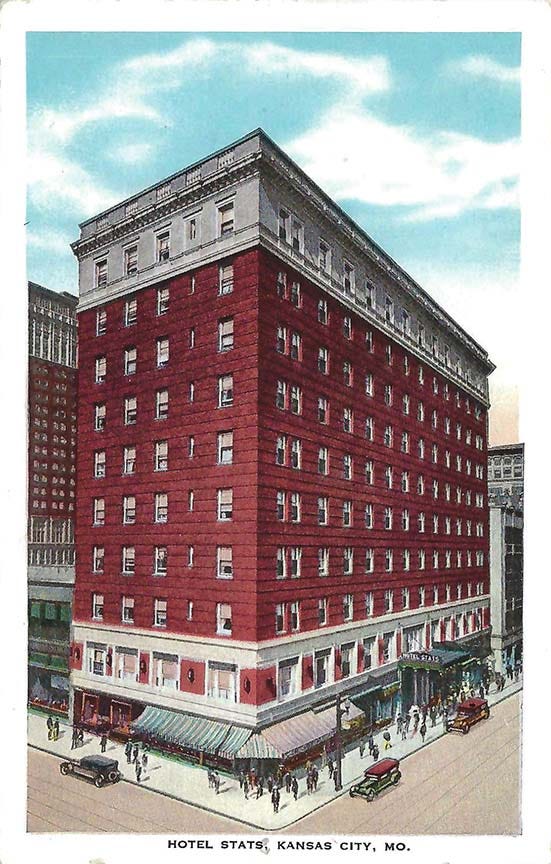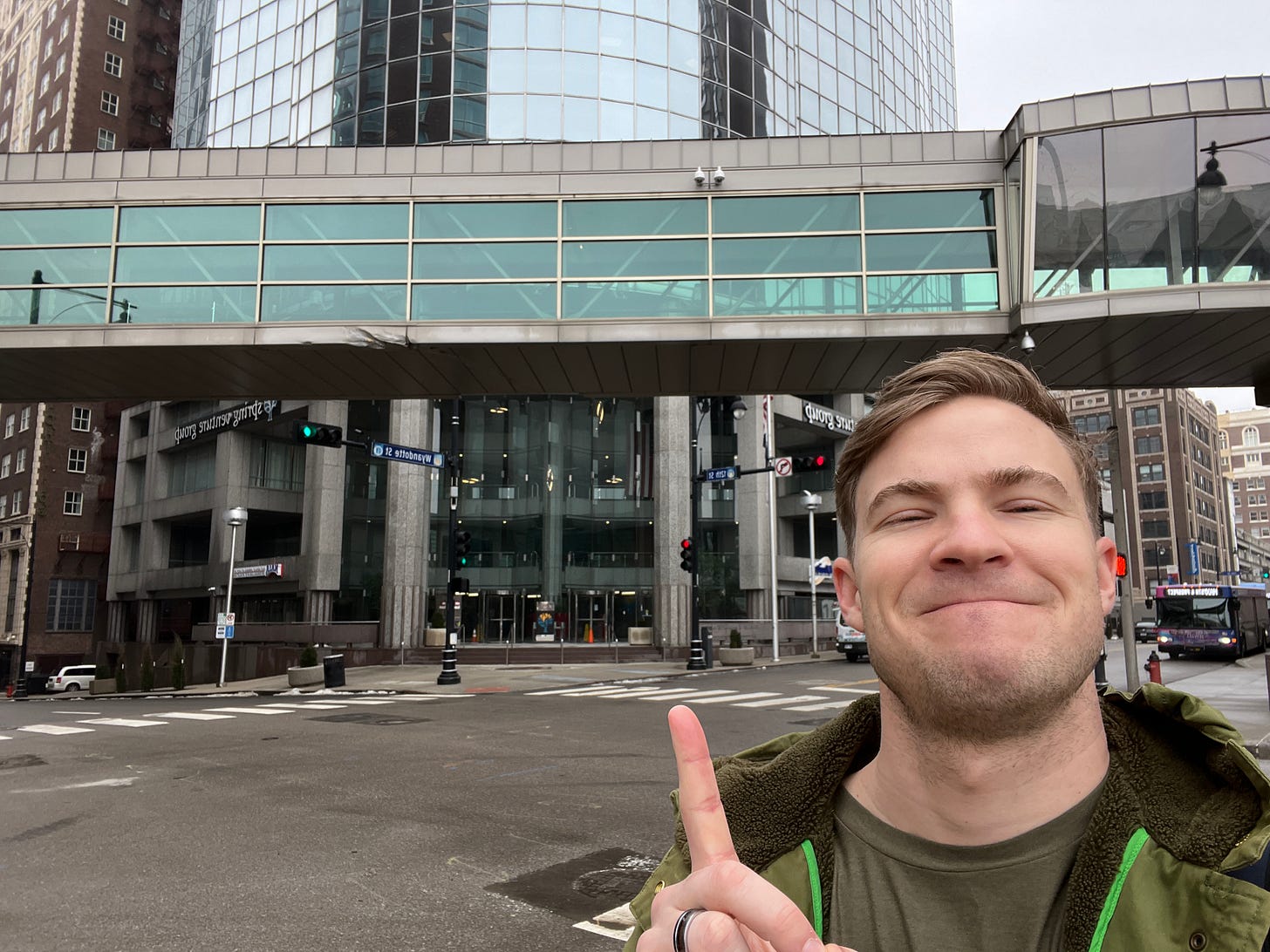Coming Back to a Table of NACHOs
And why Kansas City has a wildly important part of LGBTQ history
Hello from Kansas City! This week, we are performing in such a unique theatre. I've never seen one built quite like it. And we've officially crossed halfway through our six one-weekers in a row, and I'm so excited to settle into Chicago for two whole weeks in February. This week we've got another nonprofit, a new Queer song, some fascinating history that is a block from our hotel, and one of my favorite little musing/relationship pieces I've written down at the bottom. So, let's dive on in!
Nonprofit #10 of the QNP here in Kansas City is the Kansas City Center for Inclusion! They are another LGBTQ center similar to the QMNTY center in Pittsburgh, founded in 2012 as the LikeMe Lighthouse but rebranded in 2017 to what it is today. Like most LGBTQ centers around the country, they have a packed roster of events and support groups, and I can only imagine how important these all are to the citizens of these more rural areas!
Some of the events they have include:
Movie Nights: Members of the Religious Trauma Support Group, along with any of our allies in the community, are welcome to join us for a cozy movie night at Plexpod in room 2J. We will be watching 1946: The Mistranslation That Shifted Culture.
LGBTQ+ Religious Trauma Support Group: This support group is open to anyone in the LGBTQ+ community who has been harmed by or disappointed in religious institutions. We want to create an affirming space in Kansas City for queer people of any faith or no faith, to process some of their experiences together. Group leaders are all LGBTQ+ identified and trained in trauma-informed practices.
KCCI's LGBTQ+ Disability Support Group: This group meets virtually once a month on the second Friday at 6:00 PM. This is a space for people to create connections, process some of the issues related to being both queer and disabled, and offer support to one another. Facilitators are volunteers from the community who are both queer and disabled.
Rainbow Club: KCCI has partnered with the KC Public Library to bring you Rainbow Club (also known as Frog Club) for kids in grades K-5.
Needle in a GayStack: Join queer friends and allies of all ages for hanging out and working on our projects, whether you're a knitter or a quilter or simply want to draw in your sketchbook.
Those are just a few of the events they have. They also have a binder exchange program, a community closet, and an ASL practice club with pizza! The donations you give will go towards all of this programming and, honestly, maybe to the pizza! This is City 4 of 6 in a row, so as always, all I'm asking for is $5. As always, donate via Instagram (live around one) or Venmo if that is what works for you! Wooooo, we're on the other side of the streak hill!
One block from our company hotel is the intersection of 12th St and Wyandotte. Now, there's a towering glass building housing the Spring Venture Group, but in 1966, that corner belonged to the Hotel State. This hotel was the meeting place for the first-ever national gathering of lesbian and gay rights activists. Prior to 1966, there were many gay rights groups around the country, but this was the first time they banded together on a national scale.
Forty representatives from nearly 15 organizations met on February 19-21 in the chilly Kansas City Winter. Kansas City was chosen not only because of its central location but also because of its vibrant social scene. Throughout the two-day event, the representatives decided on a national strategy for a legal defense fund and planned coordinated demonstrations for LGBTQ equal rights. Lastly, they signed a unification policy statement that officially bonded the groups nationally.
But this organization was fraught with ideological differences like all big movements. The groups could not agree on whether or not the organizations should work separately or together. Should they strive for homogeny or independence? Should they try to earn the respect of the straight population or demand their equal rights? Lesbians, in particular, were worried that the men would co-opt the movement and the organization would be dominated by the gay agenda instead of a more equal one.
But in spite of all these differences, everyone agreed that the movement needed a national presence, and out of that agreement came NACHO (pronounced Nay-Ko).
"In August 1966, six months after the meeting in Kansas City, delegates gathered in San Francisco and held the first North American Conference of Homophile Organizations—or NACHO. Even the organization's name as a collection of homophile organizations reveals the degree to which members were reluctant to lose their organizational independence. Perhaps the greatest contribution of the NACHO gatherings came from their 1968 Chicago conference. There, members agreed on a slogan, introduced by legendary Mattachine Society activist Frank Kameny: "Gay is Good." More importantly, NACHO members adopted a five-point "Homosexual Bill of Rights."
-From the Pheonix Society
On the 12th of January, our lord and savior, Lil Nas X, released his first single since his debut album, and it got everyone up in a tizzy. To catch you up, Lil Nas X is a musician, brilliant at stirring up social media to create newsworthy hype. His 2021 song "Montero (Call Me By Your Name)" is full of biblical imagery, including him pole dancing down to hell and giving the devil a lap dance before snapping his neck and taking his place. This video is a fuck you to all the conservative Christians who said that he'd go to hell for being gay. Naturally, the video created outrage, and in response, he created his own 'Satan's Shoes', complete with a drop of blood. The shoes retailed for $1,018 and sold out in under a minute.
Almost two years later, he's now released "J Christ," another song full of biblical imagery, but this time he's swapped sides, embodying Jesus Christ. The theme is that Jesus had the greatest comeback of all time, and so will Lil Nas X. The music video is a fountain of creativity, and his unashamed fierceness and brilliant understanding of how social media works made it rise instantly to the most streamed video on YouTube when it was released. But that's enough from me; I'll just let the music video speak for itself.
How do you come back to the table?
Last week, P!nk posted about her 18-year anniversary with her husband, and it was such a beautifully honest sentiment that it sat with me all week. So, I wanted to explore her concept of coming back to the table. But first, here's the caption.
"Love is a lifetime of coming back to the table. We almost didn't make it to this one, well a couple of them, if I'm being honest. When I met you, 22 years ago, I just wanted someone that wouldn't lie to me. I didn't have a clue about commitment, building a life together, intimacy, trust. It's fucking hard. But man if I'm not humbled by the surprise of loyalty, history, forgiveness, and resilience. How love rearranges itself and reappears after an empty night or five. I'm proud we made it to the other side of this year. I wear our scars proudly. You are my stubborn, beautiful, immovable rock."
So much of a relationship is how you fix problems. Every relationship has them, and to think otherwise, while optimistic, is foolish. In the spirit of Romantic Pessimism, there isn't a single person with whom you will not have problems. And that is simply because we are all so beautifully, brutally flawed. We have triggers we don't understand, we have countless annoying habits, and we have our own particular ways of doing things that we've learned from our time as single people. So, how do we mesh our imperfections with someone else's in a way that won't destroy the relationship? How can we come back to a relationship with grace?
Many books, think pieces, and articles try to teach people the best ways to avoid conflict. Conflict in relationships is frequently seen as a death knell, a sign that something is wrong with the coupling. But I see conflict as a fascinating way to actually grow closer to whoever you're arguing with. I usually 'celebrate' the first arguments I have with new friends because it shows that our relationship has progressed to a point where we can disagree. And it shows that we care enough about each other to come back to the relationship after the argument has passed.
I think the biggest part of coming back to the table involves a humbling of self. I am a very proud person, so this is quite challenging for me. I know that I shouldn't try to come back in that way before I'm ready, even if I want to 'solve' the problem as fast as possible. But this is a good exercise for me because my L for 2024 is "less pride." I also find pride in being right, which is a surefire way to come back to the table badly. The desire to be right will never help conflict resolution. Don't come back until you're ready to truly listen to what the other person has to say. And that can take time. The worst part about conflict resolution that I've found, however, is that there are many times when all you can do is sit with your feelings. Time is truly the great equalizer, and sometimes nothing can be said and the time away from the table is exactly what you need to come back together.
The flip side of this argument, however, is knowing when to walk away from the table. There is a deep strength in continuing to show grace towards someone you're in conflict with, but there is also power in knowing when you've done all you can. If you've tried repeatedly with the same results, the odds are that change is not coming. But this is a two-way street. If your partner is asking for changes, you should always try to explore whether or not you can live with those compromises or, at the very least, understand where they are coming from. But if you've tried and aren't willing to change that part of yourself, then it is okay to walk away and stand strong in your convictions.
So, is there someone in your life that you can come back to the table for? Or have you been continuously coming back to the table for someone who might not be worth it? Or does this change how you've viewed conflicts you've had in the past?
Well, friends, that is all from me this week! I hope you're all staying warm and cozy and finding ways to not let the winter greys get to you. Take some time for yourself this week and do something that brings you joy!
All my love, Aidan













Good newletter! I did not know about the 1966 gay and lesbian gathering. My personal experience when I entered the scene in the late 70s was gay and lesbian groups were fractured and not of one voice. I saw that change in the 80s with AIDS.